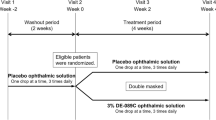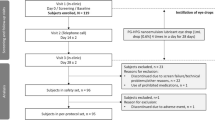Abstract
In an open label, two period cross-over study we compared the ocular tolerability of NODS vs. Isopto-NaturaleR eye drops. Thirty healthy volunteers were asked to rate the application system they were using for ocular discomfort, utilizing a visual analog scale in which 100=no ocular discomfort and 0=severe ocular discomfort. In addition each subject had to answer a questionaire and underwent a full ophthalmic control before, at day 7, at day 14 and at day 21 of the study. Each application form had to be applied to one eye only once a day for 7 days, followed by a washout period of 1 week. The type of application form was then changed and again had to be applied to one eye only for 7 consecutive days, followed by a final ophthalmic examination. The mean irritation score was recorded at day 7 and at day 21 of the study. Volunteers had no history of eye disease, no acute pathology of the eye, no contact lenses, no conditional foreign body of the cornea within the last four weeks prior to the study or within the study, no local therapy, no systemic therapy, no diabetes, no pregnancy. Informed consent was obtained. At day 1 one of the two application forms was given to each volunteer in a randomized order. 29 volunteers finished the protocol (16 male, 13 female); mean age: 26 years (range 20–32 years). The mean irritation score of NODS: 35 (2-81); the mean irritation score of Isopto-NaturaleR: 80.4 (45.5–99). The difference of mean irritation score (NODS vs. Isopto-NaturaleR): 46.7 (3.3–82.1) (p<0.01). The results of the study indicate that in healthy volunteers NODS are not as well tolerated as conventional eye drops when compared for ocular discomfort. However, the chance of applying drugs without preservatives and the possibility of increasing the rate of bioavailability from the new route (NODS) as well as the proportionally reduced risk to the patient of systemic side effects after NODS application of any type of drugs should be taken into consideration.
Similar content being viewed by others
References
Alani SD. The ophthalmic rod: description of a disposable ophthalmic drug delivery device. Acta Pharm Suic 1978; 15: 237–40.
Alani SD. The ophthalmic rod: A new ophthalmic drug delivery system I. Graefes Arch Clin Exp Ophthalmol 1990; 228: 297–301.
Collin HB. Ultrastructural changes to corneal stromal cells due to ophthalmic preservatives. Acta Ophthalmologica (Copenhag) 1986; 64: 72–8.
Fraunfelder FT, Meyer SM. Drug-induced ocular side effects and drug interactions. Leo & Febiger, Philadelphia, London, 1989; 476–9.
Gardener SK. Ocular drug penetration and pharmacokinetic principles. In: Lamberts DW, Potter DE (eds) ‘Clinical ophthalmic pharmacology’. Little & Brown, Boston/Toronto, pp 1–51, 1987.
Gasset AR, Ishii Y, Kaufman HE, Miller T. Cytotoxity of ophthalmic preservatives. Am J Ophthalmol 1974; 78: 98–105.
Kelly JA, Molyneux PD, Smith SA, Smith SE. Relative bioavailability of pilocarpine from a novel ophthalmic delivery system and conventional eye drop formulations. Br J Ophthalmol 1989; 73: 360–2.
Kilp H, Berwitt H. Cytotoxicity of preservatives: A scanning electron microscopic and biochemical investigation. Chibret Intern J Ophthalmol 1984; 1: 4–20.
Powell EGP. The cytotoxic activity of ophthalmic preservatives. J Pharm Pharmacol 1985; 37(suppl): 63–7.
Schlumpf R, Skinner FS. SterilitÄt und Konservierung wÄssriger Augentropfen. In: Dolder R, Skinner FS (eds) ‘Ophthalmika. Pharmakologie, Biopharmazie und Galenik der Augenarzneimittel’. Wissenschaftliche Verlagsgesellschaft mbH, Stuttgart, pp 415–441, 1990.
Shell JW. Pharmacokinetics of topically applied ophthalmic drugs. Surv Ophthalmol 1982; 26: 207–18.
Sherwood MB, Grierson I, Millar L, Hitchings RA. Long-term morphologic effects of antiglaucoma drugs on the conjunctiva and tenon's capsule in glaucomatous patients. Ophthalmology 1989; 96: 327–35.
Wright P. Squamous metaplasia or epidermalization of the conjunctiva as an adverse reaction to topical medication. Trans Ophthalmol Soc UK 1979; 99: 244–6.
Author information
Authors and Affiliations
Rights and permissions
About this article
Cite this article
Diestelhorst, M., Krieglstein, G.K. The ocular tolerability of a new ophthalmic drug delivery system (NODS). Int Ophthalmol 18, 1–4 (1994). https://doi.org/10.1007/BF00919405
Received:
Accepted:
Issue Date:
DOI: https://doi.org/10.1007/BF00919405




